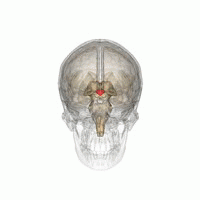Hypothalamus

The hypothalamus is a region of the forebrain below the thalamus that coordinates both the autonomic nervous system and the activity of the pituitary, controlling body temperature, thirst, hunger, and other homeostatic systems, and involved in sleep and emotional activity.
The body has standard levels where it is best able to function. If these levels change for any reason, the hypothalamus detects the change and sends out neural signals or hormonal messaging to the affected tissues. For example, when temperature is increased or decreased, the hypothalamus initiates the process to get the body to sweat (which cools the body back to its standard temperature) or shiver (which warms the body back to its standard temperature), respectively.[1]
Functions[edit | edit source]
- Controls the pituitary
- Balancing salts and fluids in the body (useful to blood pressure, dehydration, overhydration)
- Vasopressin/antidiuretic hormone (ADH) - a hormone that causes the kidneys to retain more water.[2]
- Sex organ processes, labor, and breast milk production
- Oxytocin - released by the hypothalamus, has general function on moderating emotion and behaviors such as bonding, sexual arousal and recognition, and also sends hormones to the reproductive organs during childbirth.
- Gonadotropin-releasing hormone - causes the pituitary to produce follicle stimulating hormone (FSH; causes ovaries to produce estradiol and start ovulation, and causes the testes to both start the process of creating sperm and send signals back to the pituitary to stop sending FSH), and luteinizing hormone (LH; causes the ovaries to produce steroids such as progesterone, and causes the testes to produces steroids such as testosterone).[2][3]
- Metabolism
- Thyroid stimulating hormone - released by the hypothalamus acts on the thyroid to regulate breathing, heart rate, body temperature, some feeding and drinking behaviors etc.[4]
- Circadian rhythm (body clock and sleep/wake cycle)
Once the hormones have performed the desired function, the tissues produce chemicals that are sent back to hypothalamus telling it to stop producing the hormones. This loop of signaling ensures that the hypothalamus does not overproduce hormones, maintaining order in the body.[1]
Hypothalamic dysfunction[edit | edit source]
General dysfunction[edit | edit source]
Dysfunction of the pituitary can be caused by a number of events: damage to the brain, genetic predisposition, tumors, eating disorders, and autoimmune disorders. This dysfunction can lead to under- or overproduction of hormones which can lead to problems such as low body water (underproduction of vasopressin), inability to sense satiety (excessive appetite), mood swings, headaches, vision problems especially loss of peripheral vision, word-finding difficulties, and insomnia.[5][6][7]
Sleep dysfunction in ME/CFS[edit | edit source]
A common symptom of ME/CFS is sleep disturbances. These perturbations in the regular sleeping cycle may have deleterious effects on biological processes and the progression of a condition such as ME/CFS. During sleep deprivation, studies show that there is dysregulation of enzyme complexes in the hypothalamus among other brain structures. These enzymes complexes play a role in the oxidative and nitrosative stress pathways, which if disrupted, can lead to blood brain barrier perforation and neuroinflammation (See Oxidative Stress under Neuroinflammation).[8]
Another study found that ME/CFS patients have altered circadian rhythms and skin temperatures that do not follow normal patterns (e.g. temperature decreasing in the evening near bedtime). These functions are related to the hypothalamus and suggest that there may be hypothalamic dysfunction.[9]
See also[edit | edit source]
Learn more[edit | edit source]
- The Pituitary Gland and Hypothalamus - Open Stax
- Hypothalamic dysfunction - Mount Sinai
References[edit | edit source]
- ↑ 1.0 1.1 Thomas, Nihal; Kapoor, Nitin; Naik, Dukhabandhu (December 18, 2015). 55 Chapter Hypothalamus and Hypothalamic Disorders HYPOTHALAMUS AND HYPOTHALAMIC DISORDERS ANATOMY AND DEVELOPMENT OF THE HYPOTHALAMUS Gross Anatomy.
- ↑ 2.0 2.1 Betts JG, Young KA, Wise JA, Johnson E, Poe B, Kruse DH, Korol O, Johnson JE, Womble M, DeSaix P (April 25, 2013). "17.3 The Pituitary Gland and Hypothalamus - Anatomy and Physiology". Anatomy and Physiology. OpenStax. Houston, Texas.
- ↑ "FSH and LH". mcb.berkeley.edu. Retrieved October 25, 2018.
- ↑ "Thyroid Gland: Overview". EndocrineWeb. Retrieved October 25, 2018.
- ↑ "What are pituitary symptoms?". The Pituitary Foundation. Retrieved March 24, 2021.
- ↑ "Pituitary Diseases". Emory Healthcare. Retrieved March 24, 2021.
- ↑ "Hypothalamic dysfunction". Mount Sinai. Retrieved March 23, 2021.
- ↑ "The putative role of oxidative stress and inflammation in the pathophysiology of sleep dysfunction across neuropsychiatric disorders: Focus on chronic fatigue syndrome, bipolar disorder and multiple sclerosis". Sleep Medicine Reviews. 41: 255–265. October 1, 2018. doi:10.1016/j.smrv.2018.03.007. ISSN 1087-0792.
- ↑ Cambras, Trinitat; Castro-Marrero, Jesús; Zaragoza, Maria Cleofé; Díez-Noguera, Antoni; Alegre, José (June 6, 2018). "Circadian rhythm abnormalities and autonomic dysfunction in patients with Chronic Fatigue Syndrome/Myalgic Encephalomyelitis". PLOS ONE. 13 (6): e0198106. doi:10.1371/journal.pone.0198106. ISSN 1932-6203. PMC 5991397. PMID 29874259.

